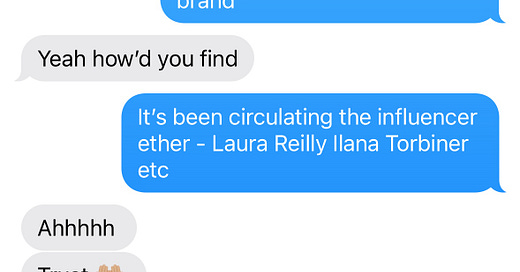The role of creative strategy in an influencer-dominated world.
In other words, how to build a brand through people.
It’s impossible to overstate how critical influencer marketing is in today’s consumer goods landscape. Product-market fit is table stakes, and long gone are the days when well-designed Instagram grids and paid ads could grow a brand alone. Consumers increasingly engage with and trust people more than brands on social media. We’re living in an influencer economy (or creator economy if you’re one of those people — it’s the same thing).
For better or worse, if you don’t have an influencer-led brand (Rhode, SKIMS, Rare, REFY, The Absorption Company, etc.), then you better have a super sharp, influencer-led marketing strategy (Salt & Stone, Merit, Dieux, Graza, Crown Affair) if you want serious funding, distribution and/or growth.
That means a combination of the founder becoming an influencer/creator, influencer equity or rev-share, aggressive seeding (we’re talking >500 gifted/month), affiliate, and aspirational owned social that attracts the influencers you seek. And the whole is exponentially greater than the sum of its parts. If a brand asks me to help them with just one of those initiatives but doesn’t want to invest in the rest, it’s likely in neither of our best interests to proceed. Without an audience, you’re a tree falling in the forest — and you can’t just post or buy your way to an audience anymore.
That said, creative strategy is what separates great brands from good brands. But now that a majority of gen alpha, gen-z and millennial consumers discover brands through influencers, its role has evolved in three key ways.
Influencer curation matters even more.
Last year, Vogue Business published a popular research piece in partnership with youth culture agency Archrival called “Gen-Z Broke the Marketing Funnel.” It showed that a majority of consumers surveyed discover brands on social media, but the report noted that “influencers are still important.” Influencer is not a place. Influencer is social media, and I bet an overwhelming majority of those surveyed discover brands through influencers on social media.
Your Instagram grid is no longer the first impression of your brand — your influencers are. Beyond optimizing for general target market and engagement rate, it’s more important than ever to curate your influencer partners, whether gifted or paid, with the same meticulousness you would an Instagram grid in 2015. And while that may sound limiting, trust me — there are a lot more influencers out there than you may think. Don’t compromise.
Packaging and product must work even harder.
What would you change if you knew that aside from influencers, your product is the first impression of your brand both on social and in retail? Does it drive desirability and is it clear enough without the context of your owned channels?
More than ever, we must design packaging and product to stand out and stand alone both in influencer content and on-shelf. Gone are the days when our brand accounts, emails and PDPs did all the heavy lifting.
Owned social is for influencers, first and foremost.
This is a hotter take, but influencers are your most important direct audience on owned social, not consumers. Consumers discover brands through influencers, and influencers discover brands directly. I cringe at how often I see brands that clearly spend significant time and energy on owned social for marginal results, cheapen their brand to drive empty engagement through short-lived trends, or promote flash sales on organic social in the hopes of driving revenue. Your owned social should be the most creatively aspirational impression of your brand, one your target influencers will be proud to align with.
If you’re the 1% of brands with a brilliant creative strategy, your owned social can be your best growth asset. If you’re the 99%, don’t fall into the trap of thinking you can still content-pillar and post-cadence your way to growth. Your time and money is likely better spent on influencer and community. Take jewelry brand Dorsey, for example — they have a beautiful, mostly static grid that they update occasionally, and are hyper-focused on affiliate marketing. And they’re crushing it.
“But Jess, owned social is free! Influencer is too expensive!” No, owned social is not free. If you’re doing owned social right, it’s one the most time and human resource-consuming marketing outputs. And no, influencer doesn’t have to be too expensive. Gifting and affiliate marketing are two of the most ROI-positive tactics in marketing right now. And not to mention, when you’re investing strategically in influencer — social proof, trust, awareness — you’ll notice a sustained lift on brand and growth KPIs. If not, there’s probably a deeper issue.
If you’re a founder or leader who needs help with any or all of the above, let’s chat — jessicaneggert at gmail dot com. I have some bandwidth for consulting or advising, and I love this stuff more than anything except for my dog Gracie.








10000% agree with your point on organic social being for influencers. It took me way too long to come to this perspective. I wish someone just drilled that into my head a few years ago.
Thank you so much for your kind words. We (the entire team at Dorsey and I!) really appreciate it so much.